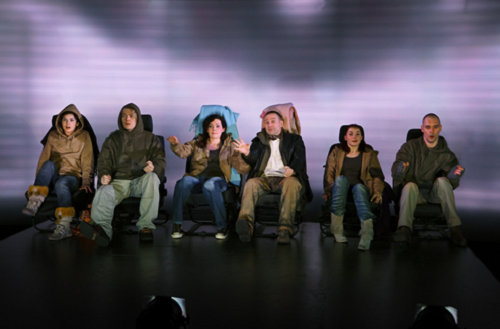Matti Linnavuori[1]

Tyttö tuli! Author and director: Otso Kautto. Light, sound and video: Mikko Hynninen. Stage design and costume: Nina Mansikka.Venue: The National Theatre, Helsinki, Finland. Run: 13 February 2009 to January 2010.
Normally one cannot expect to be intellectually impressed when viewing a new Finnish play. Finnish texts regularly portray characters with an obsession, and the production then is a series of loud physical manoeuvres, in which the protagonist pursues his obsession. This is in conflict with his girlfriend and/or others who act in a permanent state of rage as well. Permanent, however, usually means short-lived but noble in an obscure fashion. If a motivation is given, its analysis may be heartfelt but shallow, a mere conviction that the society is rotten.
In the 1990s young playwrights began to give reasons for this rage, from family history and growing pains, particularly Reko Lundán in his Einer verirrt sich immer (1998) and Can You Hear the Howling / Quand rôdent les chiens-loups (2001). No longer trying to overthrow the existing social order by the sheer volume of one’s shout, Lundán’s approach meant that the rage gained different shades of meaning, e.g. disappointment and timidity.
Thinly veiled autobiography, perhaps, and then it is only logical to further thin the veil.
In competition against reality television the theatre looks clumsy. Why spend six weeks rehearsing a story about made-up characters, when real people are only too willing to expose everything live between commercial breaks? Finnish theatre has tackled this problem by employing some tools of reality television, but not to maximize gossip and self-pity. In Odotus (2009, The Wait, a Performance about Characters Named Pirkko Saisio and Marja Packalén), two sixty-year old actresses Pirkko Saisio and Marja Packalén exchange relaxed dialogue about life in general, their careers, looks, former boyfriends and girlfriends, politics in a spirit where feminine self-doubt mixes with amused butch arrogance. The changes of atmosphere always surprise the audience, both because of the command these veterans have over their stage skills, and because of the intellectual alertness of the text. The director Heini Junkkaala edited it down to 100 minutes from 600 transcribed pages of taped reminiscences of the performers.
Otso Kautto (born 1962) is a father of four daughters. His family divides its time between Finland, France and Spain, which means countless hours spent in a car. Kautto’s first novel Matka Mundakaan (2003, The Road to Mundaka) is the story of a surfboarder in search of a good wave in the Bay of Biscay. Kautto has numerous kilometres under his belt also as a member of the Finnish international swimming team in his youth. Therefore, it would be tempting to see his Tyttö tuli! (It’s a Girl!) as an autobiographical piece. The play portrays fathers and daughters driving around on the roads of Europe. In the programme Kautto says that the play is too personal to be autobiographical.

© Vertti Teräsvuori.
In Nina Mansikka’s set there are six front seats of a car side by the side on the stage. On the back wall Mikko Hynninen’s blurry video shows an anonymous road which the characters keep leaving behind.
There is very little traditional acting for the three fathers and three daughters. Most of the time they remain seated, keeping their hands on an imaginary steering wheel. Kautto writes in the programme that in a normal play the actors get to act the subtext, but here the playwright has spelled it out in its entirety. The characters do their best to voice every possible archetypical and subconscious motivation there could be in a father-daughter relationship. In Finland, both artists and critics place great value on “sincerity” or “being genuine,” i.e. portraying emotional turmoil. In this production sincerity takes place in the actors’ minds rather than their gestures, which is rare. There is a light-hearted and poetic innocence in the atmosphere of the production.
The actors change pairs twice during the course of the performance to emphasize that this is about all fathers and daughters, not about specific individuals. The fathers are middle-aged but also dead in some scenes; the daughters’ age varies from thirteen to near thirty. Kautto also considered a final scene where the fathers would be old and blind, and they would drive once more to their favourite spot, and the daughters would describe how it looks now, and nothing has changed, which makes the fathers very happy, and the audience would see that the daughters talk about the landscape in an old photograph they are holding. This scene exists only in the author-director’s foreword in the programme.
The play is about letting go, about coming to terms with growing up. A scene does not really lead to the next scene; every scene is a variation of the same situation. Driving is not just a phase, the father says, when the daughter wants them to reach a destination. Kautto seems to joke with a cliché theatre makers love, in interviews in particular, that life is a journey. Kautto is so fond of the act of travelling that here driving is no metaphor. The driving is endless, beyond mortality, and therefore there is time and opportunity to discuss, confess or deny anything and everything to their hearts’ content. And they do. However, the play is by no means a collection of quotable aphorisms.
Kautto combines poignant observations with unmasked honesty in an intellectual dialogue. Below I translate and paraphrase my favourite train of thought in the play to give you an idea of how Kautto’s argument goes. Perhaps I should not. As a father says in the play, dreams are tricky: if one voices them and talks about them, they wane into topics and lose their magic. Please take the risk and read on.
Having daughters allows fathers to stay young, whereas having sons instantly makes fathers old. Sons replace their fathers, but daughters cannot realize their fathers’ dreams for them.

© Vertti Teräsvuori.
One dream a parent has is for his or her child to be happy. The daughter says: “It is a terrible burden to try and get a happy life so that you can be happy. It would be far easier if you wanted me to become rich or successful.”
Both fathers and daughters regret that growing up means giving up certain hugs. The father’s friends now sneak a look at the daughter’s breasts, and the daughter asks if the father looks at her friends the same way. The daughter says: “Everything you did to women will be done to me.” This is exactly what the father cannot bear, and he devotes plenty of time and effort to self-defensive exercises. (The martial arts moves give the actors an opportunity to change pairs in the course of the production.)
One half of a daughter is born of the father, and because parents and children love each other unconditionally, it is stronger than the loyalty within the female gender: the daughter understands her father better than the wife does, and they are all aware of it. Sex, however, is the wife’s domain.
During stops at cafés along the road people stare at them. Women disapprove of seeing an older man together with a young woman, and men envy the father, until the daughter says “papa” loud enough for everyone to hear in the café. The fathers and daughters are thrilled by the attention.
The daughter asks the father whether he was disappointed, because a girl was born instead of a son. The father says no. The daughter quips: “You hesitated one hundredth of a second too long before answering.” The father says it took him all that time to think how to give an answer which would not be wrong. The daughter says casually: “So you were not disappointed?” and the father says no. The daughter: “This time you answered too quickly.”
The fathers were Jukka-Pekka Palo, Kasper Nordman and Ville Keskilä, the daughters Marja Salo, Leena Pöysti and Marjaana Maijala.


[1] Matti Linnavuori is a free lance critic of theatre and television. He writes for Finnish newspapers and Teatteri Journal. Since the early 1990’s he has written, translated and directed radio plays for YLE the Finnish Broadcasting Company. He is also the co-author of one stage play.
Copyright © 2009 Matti Linnavuori
Critical Stages/Scènes critiques e-ISSN: 2409-7411
This work is licensed under the
Creative Commons Attribution International License CC BY-NC-ND 4.0.
